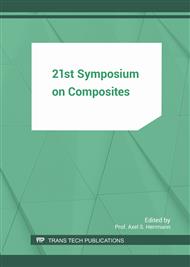p.740
p.745
p.753
p.763
p.778
p.786
p.793
p.800
p.807
Polypropylene Based Piezo Ceramic Compounds for Micro Injection Molded Sensors
Abstract:
Polymer matrix compounds based on piezo ceramic and electrically conducting particles within a thermoplastic matrix show distinctive piezoelectric and dielectric effects which can used for sensor applications. The electrical and mechanical properties can be adjusted in a wide range by varying the ratio of active filling particles and the matrix materials. The sensor effect of the compound is generated by the ceramic particles. A large ratio of piezo ceramic powder facilitates a high sensitivity. The electrical permittivity of the otherwise insulating matrix polymer can be adjusted by the amount of conductive filler. An aligned permittivity leads to a stronger electrical field in the ceramic particles. In contrast, too many conductive particles create a conductive network in the compound which short-circuits the sensors. The piezo ceramic compounds can be processed via micro injection molding for application as ceramic sensors. This offers a wide range of new sensor design variants, notably three-dimensional and highly complex geometries. However, there are two main demands for a highly sensitive sensor, which are conflicting. On the one hand the filler content of piezo ceramic particles in combination with electrical conductive carbon nanotubes must be very high, on the other hand the wall thickness should be as thin as possible. For filling cavities with a high aspect-ratio in an injection molding process, low viscosity polymer melts are necessary. These process characteristics conflict with the increasing viscosity by filling the melt with the particles. The sensor measuring area has to be designed as thin walled as possible. In order to overcome this obstacle a dynamically tempered mold design is applied to avoid solidification of the melt, before the mold is completely filled. The mold can be tempered by Peltier elements. The fully electric tempering is cleaner, more precise and more reliable than conventional water or oil tempering.
Info:
Periodical:
Pages:
807-814
Citation:
Online since:
July 2017
Price:
Сopyright:
© 2017 Trans Tech Publications Ltd. All Rights Reserved
Share:
Citation:


